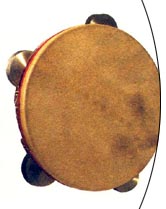Daire/Tef (tambourine)
Daire/Tef (tambourine)
 This
percussion instrument was used in various ways by the ancient civilisations in
Anatolia, Mesopotamia and Egypts, and by those that followed, as well as by the
Ottomans for both religious and secular purposes. It then moved on from those
regions to Europe.
This
percussion instrument was used in various ways by the ancient civilisations in
Anatolia, Mesopotamia and Egypts, and by those that followed, as well as by the
Ottomans for both religious and secular purposes. It then moved on from those
regions to Europe.
The daire is about 30-40 cm. in diameter, and is made by stretching animal
skin over one side of a wooden rim, generally made of walnut. Bronze discs,
generally in pairs, are attached to struts running through holes in the rim.
When the skin is struck, these discs rattle, producing a more colourful sound.
As well as discs, various chains and links have also been employed. The
instrument can come in different sizes, and large ones were used by shamans in
former time, giving rise to the name ‘shaman tambourine.’ Versions without bells
are more generally used in a religious context, and are called ‘bendi,’ ‘bender’
or ‘mazhar.’
Smaller tambourines are known as ‘tef,’ and these normally have a diameter of
28-30 cm. These are known as ‘duf’ in Persian and ‘defik’ in Arabic, and it is
from these that the Turkish name comes. The most popular skins are dog and calf,
although the skins of other animals are also used. The rım of the tef is usually
4-6 cm. tall. The rim is frequently decorated with veneers of various woods or
ivory, mother-of-pearl and tortoiseshell, making them more valuable.